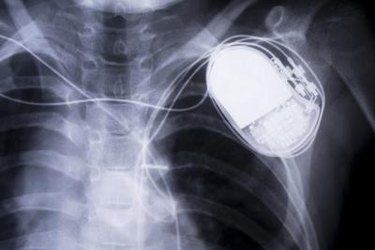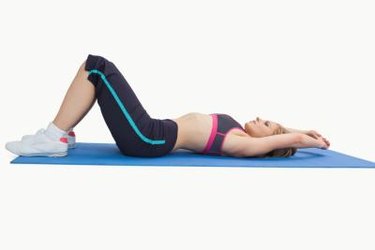
Pacemaker surgery affects more than just your heart. After this procedure, your doctor will likely limit what you can do with your arm for the first couple of months. Movement is restricted to allow your body to heal with the pacemaker in the correct position.
Exercises help you regain arm range of motion after pacemaker surgery. However, due to the serious nature of this condition, consult your doctor before performing any shoulder exercises to be sure they are safe for you.
Video of the Day
Video of the Day
Read more: Exercises with a Pacemaker

Range of Motion Exercises
Range of motion exercises reduce shoulder stiffness after pacemaker surgery. Initially, these exercises might be more comfortable when performed lying down.
Flexion
Shoulder flexion allows you to lift your arms out in front of you and reach overhead. This movement is often limited to 90 degrees for 4 to 6 weeks after pacemaker surgery.
Step 1
Lie on your back on a firm surface. Bend your knees and place your feet flat on the surface. Bring your hands together in front of your hips and interlock your fingers.
Step 2
Keeping your elbows straight, slowly lift your hands up toward the ceiling, then overhead, as far as possible. Use your stronger arm to assist the weaker one. Hold this position for 2 to 3 seconds.
Step 3
Slowly bring your hand back down to your hips. Repeat this exercise 10 times and work up to three sets in a row.
Cross Body Adduction
Reaching across the body is an important movement for getting dressed, putting on your seatbelt and driving.
Step 1
To stretch your right shoulder, bring your right hand across your chest to your left shoulder. Place your left hand on the back of your right elbow and slowly press until you feel a strong pull in your right shoulder. Do not stretch to the point of pain.
Step 2
Hold the stretch for 20 to 30 seconds, then relax. Repeat three times.
Internal Rotation
Internal rotation allows you to reach behind your back. The towel stretch improves internal rotation.
Step 1
Begin with the towel in your left hand to stretch your right shoulder. Standing up, reach overhead with your left hand, dangling the towel along the middle of your back.
Step 2
Reach behind your back with your right hand and grab the opposite end of the towel. Slowly pull the towel up toward the ceiling with your left hand until you feel a strong stretch in your right shoulder.
Step 3
Hold this position for 20 to 30 seconds, then relax. Repeat three times.
External Rotation
External rotation occurs when your arm turns out, away from your body.
Step 1
Interlock your fingers and bend your elbows to 90 degrees. To stretch your right shoulder, keep your right upper arm next to your side.
Step 2
Using your left hand, slowly push your right forearm away from your body as far as possible. Hold this position for 20 to 30 seconds, then relax. Repeat three times.
Abduction
Abduction is movement of your arm, straight out to the side.
Step 1
Cradle your right arm by resting your right elbow in your left hand. Using your left hand, slowly push your right upper arm out to the side as far as possible.
Step 2
Hold for 20 to 30 seconds, then relax. Repeat three times.
Extension
Extension allows you to move your arm backward. Extension exercises can be performed with a cane, broomstick or similar household item.
Step 1
Place the stick behind you, across your lower back. Hold one end of the stick in each hand.
Step 2
Slowly lift the stick out away from your back as far as possible. Do not bend forward -- stand up straight throughout this movement.
Step 3
Hold for 20 to 30 seconds, then relax. Repeat three times.
- Aurora Health Care: Range of Motion Exercises for the Pacemaker Patient
- Brigham and Women's Hospital: Physical Therapy: Standards of Care: Cardiac
- Hunterdon Orthopedic Institute: The Stiff Shoulder: Shoulder Range of Motion Exercises
- Advance Healthcare Network for Nurse Practitioners and Physician's Assistants: The Essentials of Pacemaker Therapy
- The Ohio State University: University Medical Center: Self-Range of Motion Exercises for Shoulders, Arms, Wrists, Fingers